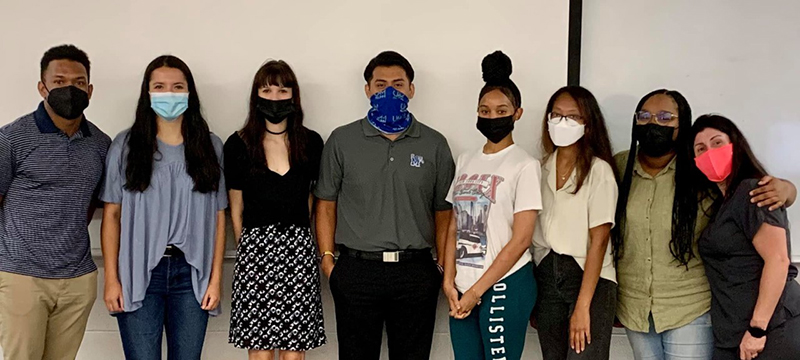Faculty Mentors and Program Participants
The common research goal of all of the Behavioral Neuroscience faculty is to advance understanding of the biological basis of behavior and cognition. In pursuit of this objective, the faculty listed below use a wide variety of methods including experimental analysis of animal behavior, in vivo neurochemical and electrophysiological measures, and psychopharmacological interventions. Select topics of interest include the neurophysiology of drug and alcohol addiction, genetic basis of behavior, neural substrates of social behavior, executive function, and motivation. Research is highly collaborative. See below to learn more about the planned research projects of each of the faculty mentor. You can also click on each faculty mentor’s name to be redirected to their faculty page.
Participating Faculty
 Melloni Cook – Dr. Cook’s lab examines the genetic basis of complex traits. As a member of Complex
Trait Consortium and the Tennessee Mouse Genome Consortium, Dr. Cook and colleagues
have identified gene networks involved in alcohol and stress responses. Dr. Cook’s
lab utilizes a range of behavioral techniques (open field, fear extinction, light/dark
box, elevated plus maze, tail suspension tests) in inbred mouse strains and genetically
modified mice to help identify genetic influences and resulting pathologies related
to disorders such as anxiety, post-traumatic stress disorder (PTSD), substance use
disorder, schizophrenia, and depression. Current and upcoming projects in Dr. Cook’s
lab are focused on characterizing strain effects on behaviors related to PTSD. The
genetic underpinnings of PTSD have not been fully explored, and novel mutant mouse
strains that express symptoms of PTSD are being pursued. Dr. Cook’s lab is currently
comparing such behavioral responses in C57BL/6J (B6) and DBA/2J (D2) inbred mouse
strains that differ in learning and memory- and in fear-related paradigms, anxiety-related
behaviors, and stress responses. B6 and D2 strains are the parental strains of the
largest extant recombinant inbred mouse panel (the BXD RI strains) which will be used
in upcoming studies in Dr. Cook’s lab. BXD strains present a variety of phenotypes
and have been used for over 25 years to map Mendelian and quantitative trait loci;
however, few researchers have characterized BXD mice on PTSD phenotypes. Students
in Dr. Cook’s lab will gain experience in animal husbandry, genotyping, the above-mentioned
behavioral assays, and complex data analysis. Identifying genetic markers of psychological
disorders allows for the creation of clinically relevant animal models and a better
understanding of neuropathologies and treatments.
Melloni Cook – Dr. Cook’s lab examines the genetic basis of complex traits. As a member of Complex
Trait Consortium and the Tennessee Mouse Genome Consortium, Dr. Cook and colleagues
have identified gene networks involved in alcohol and stress responses. Dr. Cook’s
lab utilizes a range of behavioral techniques (open field, fear extinction, light/dark
box, elevated plus maze, tail suspension tests) in inbred mouse strains and genetically
modified mice to help identify genetic influences and resulting pathologies related
to disorders such as anxiety, post-traumatic stress disorder (PTSD), substance use
disorder, schizophrenia, and depression. Current and upcoming projects in Dr. Cook’s
lab are focused on characterizing strain effects on behaviors related to PTSD. The
genetic underpinnings of PTSD have not been fully explored, and novel mutant mouse
strains that express symptoms of PTSD are being pursued. Dr. Cook’s lab is currently
comparing such behavioral responses in C57BL/6J (B6) and DBA/2J (D2) inbred mouse
strains that differ in learning and memory- and in fear-related paradigms, anxiety-related
behaviors, and stress responses. B6 and D2 strains are the parental strains of the
largest extant recombinant inbred mouse panel (the BXD RI strains) which will be used
in upcoming studies in Dr. Cook’s lab. BXD strains present a variety of phenotypes
and have been used for over 25 years to map Mendelian and quantitative trait loci;
however, few researchers have characterized BXD mice on PTSD phenotypes. Students
in Dr. Cook’s lab will gain experience in animal husbandry, genotyping, the above-mentioned
behavioral assays, and complex data analysis. Identifying genetic markers of psychological
disorders allows for the creation of clinically relevant animal models and a better
understanding of neuropathologies and treatments.
 Deranda Lester –Dr. Lester’s lab examines presynaptic mechanisms, neurotransmitter interactions,
and neural pathways that influence dopamine transmission. Dopamine regulates behaviors
associated with action- selection in the striatum, reward in the nucleus accumbens,
emotional processing and anxiety in the amygdala, and executive functioning in the
medial prefrontal cortex. The electrochemical technique fixed potential amperometry
utilized in Dr. Lester’s lab allows for real-time, subsecond (10k samples/sec) measurement
of stimulation-evoked dopamine in anesthetized animals. A recent publication from
her lab was the first to characterize and compare specific aspects of phasic dopamine
transmission in all of the previously mentioned brain areas. Many projects in Dr.
Lester’s lab focus on deciphering the influence of other neurotransmitter systems
(such as glutamate, acetylcholine, oxytocin, opioid, and endocannabinoids) on dopamine
release and related behaviors. For example, by microinfusing drugs that act on glutamate
and/or acetylcholine receptors into the regions containing dopamine cell bodies during
in vivo dopamine recordings in the limbic regions, Dr. Lester and colleagues were
able to determine the relative contribution of each receptor type. A majority of her
current and upcoming projects are centered around understanding the neural interactions
between oxytocin and dopamine. A recent publication from her lab was the first to
show that systemic administration of oxytocin alters dopamine transmission. Specifically,
subchronic oxytocin administration decreased dopamine release and attenuated the dopaminergic
response to a psychostimulant in mice. Upcoming projects will examine the effect of
oxytocin administration on dopamine transmission in mouse models of addiction and
anxiety. Also, direct infusions of oxytocin or oxytocin antagonists into specific
brain regions during dopamine recordings will allow for improved understanding of
the neural circuitry and mechanisms involved in regulating these interactive effects.
Such projects are of particular importance given the interest in oxytocin as a treatment
for disorders such as substance use disorder, anxiety, depression, and schizophrenia.
Students in Dr. Lester’s lab will be trained in construction and calibration of carbon
fiber electrodes, stereotaxic surgery in mice, in vivo amperometric recordings, histology,
stereology, brain dissection, and data analysis.
Deranda Lester –Dr. Lester’s lab examines presynaptic mechanisms, neurotransmitter interactions,
and neural pathways that influence dopamine transmission. Dopamine regulates behaviors
associated with action- selection in the striatum, reward in the nucleus accumbens,
emotional processing and anxiety in the amygdala, and executive functioning in the
medial prefrontal cortex. The electrochemical technique fixed potential amperometry
utilized in Dr. Lester’s lab allows for real-time, subsecond (10k samples/sec) measurement
of stimulation-evoked dopamine in anesthetized animals. A recent publication from
her lab was the first to characterize and compare specific aspects of phasic dopamine
transmission in all of the previously mentioned brain areas. Many projects in Dr.
Lester’s lab focus on deciphering the influence of other neurotransmitter systems
(such as glutamate, acetylcholine, oxytocin, opioid, and endocannabinoids) on dopamine
release and related behaviors. For example, by microinfusing drugs that act on glutamate
and/or acetylcholine receptors into the regions containing dopamine cell bodies during
in vivo dopamine recordings in the limbic regions, Dr. Lester and colleagues were
able to determine the relative contribution of each receptor type. A majority of her
current and upcoming projects are centered around understanding the neural interactions
between oxytocin and dopamine. A recent publication from her lab was the first to
show that systemic administration of oxytocin alters dopamine transmission. Specifically,
subchronic oxytocin administration decreased dopamine release and attenuated the dopaminergic
response to a psychostimulant in mice. Upcoming projects will examine the effect of
oxytocin administration on dopamine transmission in mouse models of addiction and
anxiety. Also, direct infusions of oxytocin or oxytocin antagonists into specific
brain regions during dopamine recordings will allow for improved understanding of
the neural circuitry and mechanisms involved in regulating these interactive effects.
Such projects are of particular importance given the interest in oxytocin as a treatment
for disorders such as substance use disorder, anxiety, depression, and schizophrenia.
Students in Dr. Lester’s lab will be trained in construction and calibration of carbon
fiber electrodes, stereotaxic surgery in mice, in vivo amperometric recordings, histology,
stereology, brain dissection, and data analysis.
 Helen Sable – Dr. Sable’s lab is particularly focused on the DoHAD hypothesis – The Developmental
Origins of Health and Disease. More specifically, she examines how negative early
life events impact hormonal function, neurochemistry (including deficits in dopamine
pharmacology), and behavior and how these neurobiological changes contribute to externalizing
behavior/disorders later in life. One leg of her research arm is focused on examining
behavioral phenotypes of genetic and environmental (toxin-exposed) rat models of ADHD
and substance use disorder. For example, an ongoing collaboration with Cincinnati
Children’s Medical Center is assessing behavioral and neurochemical outcomes in Lphn3-/-
(i.e., knockout) rats to determine their utility as an animal model of ADHD and substance
use disorder. These results are being compared to the same outcomes in the SHR rat
(routinely used as an ADHD animal model), and rats exposed in utero to neurotoxicants
(e.g., PCBs) her lab has previously shown to increase impulsivity and addiction-related
behavior. Students engaged in this arm will learn how to design, conduct, and analyze
behavioral tests designed to assess attention and impulsivity as well as drug reinforcement
and drug-seeking. A second leg of Dr. Sable’s research will be examining the impact
of marijuana use during pregnancy of externalizing behavior of the offspring. Several
prospective longitudinal clinical studies report executive function deficits such
as impulsivity and inattention and externalizing behaviors including hyperactivity
and substance use in children and young adults whose mothers used marijuana once or
more per week while pregnant. Dr. Sable will expose female rats to the primary psychoactive
constituent of marijuana, delta-9-tetrahydro-cannabinol (Δ9-THC) before, during, and
after pregnancy (during lactation) to examine how the timing of Δ9-THC exposure during
early development affects executive function and externalizing behavior in adulthood.
Students working on these projects will gain technical computer programming experience
including working with MedState notation (operant programs), as well as coding in
MatLab and Perl (data consolidation). They will also learn how to perform rodent survival
surgeries (intravenous jugular catheters), administer intravenous drug infusions,
and conduct preconceptional and perinatal dosing in the dams.
Helen Sable – Dr. Sable’s lab is particularly focused on the DoHAD hypothesis – The Developmental
Origins of Health and Disease. More specifically, she examines how negative early
life events impact hormonal function, neurochemistry (including deficits in dopamine
pharmacology), and behavior and how these neurobiological changes contribute to externalizing
behavior/disorders later in life. One leg of her research arm is focused on examining
behavioral phenotypes of genetic and environmental (toxin-exposed) rat models of ADHD
and substance use disorder. For example, an ongoing collaboration with Cincinnati
Children’s Medical Center is assessing behavioral and neurochemical outcomes in Lphn3-/-
(i.e., knockout) rats to determine their utility as an animal model of ADHD and substance
use disorder. These results are being compared to the same outcomes in the SHR rat
(routinely used as an ADHD animal model), and rats exposed in utero to neurotoxicants
(e.g., PCBs) her lab has previously shown to increase impulsivity and addiction-related
behavior. Students engaged in this arm will learn how to design, conduct, and analyze
behavioral tests designed to assess attention and impulsivity as well as drug reinforcement
and drug-seeking. A second leg of Dr. Sable’s research will be examining the impact
of marijuana use during pregnancy of externalizing behavior of the offspring. Several
prospective longitudinal clinical studies report executive function deficits such
as impulsivity and inattention and externalizing behaviors including hyperactivity
and substance use in children and young adults whose mothers used marijuana once or
more per week while pregnant. Dr. Sable will expose female rats to the primary psychoactive
constituent of marijuana, delta-9-tetrahydro-cannabinol (Δ9-THC) before, during, and
after pregnancy (during lactation) to examine how the timing of Δ9-THC exposure during
early development affects executive function and externalizing behavior in adulthood.
Students working on these projects will gain technical computer programming experience
including working with MedState notation (operant programs), as well as coding in
MatLab and Perl (data consolidation). They will also learn how to perform rodent survival
surgeries (intravenous jugular catheters), administer intravenous drug infusions,
and conduct preconceptional and perinatal dosing in the dams.
 Nicholas Simon – Dr. Simon’s lab investigates the neurobiological basis of cost/benefit decision-making
in a rat model. One behavioral pattern reliably observed in addiction is risky decision-making,
operationalized as persistent choice of risky rewards despite the high likelihood
of negative outcomes. Dr. Simon and colleagues have established a behavioral paradigm
called the Risky Decision-making Task (RDT) that measures rat preference between small,
safe rewards and larger rewards associated with a risk of punishment (mild shock)
that escalates throughout a session. Critically, the RDT differs from other commonly
used risky decision-making protocols, which utilize loss of reward opportunity rather
than physical punishment as a risk factor. NeuroSTART students will contribute to
a variety of ongoing projects examining dopamine receptor regulation of risk-taking,
the role of amygdalo-cortical circuits in sensitivity to delayed outcomes, and neural
encoding of decision-making across the lifespan. Students in Dr. Simon’s lab will
gain experience in rat handling, a multitude of rat behavioral assays, data entry
and analysis, stereotaxic implantation surgery, brain sectioning and staining, single
unit electrophysiology, and optogenetics. Delineating the neurobiological mechanisms
underlying risky decision-making has utility for the treatment and prevention of addiction.
Nicholas Simon – Dr. Simon’s lab investigates the neurobiological basis of cost/benefit decision-making
in a rat model. One behavioral pattern reliably observed in addiction is risky decision-making,
operationalized as persistent choice of risky rewards despite the high likelihood
of negative outcomes. Dr. Simon and colleagues have established a behavioral paradigm
called the Risky Decision-making Task (RDT) that measures rat preference between small,
safe rewards and larger rewards associated with a risk of punishment (mild shock)
that escalates throughout a session. Critically, the RDT differs from other commonly
used risky decision-making protocols, which utilize loss of reward opportunity rather
than physical punishment as a risk factor. NeuroSTART students will contribute to
a variety of ongoing projects examining dopamine receptor regulation of risk-taking,
the role of amygdalo-cortical circuits in sensitivity to delayed outcomes, and neural
encoding of decision-making across the lifespan. Students in Dr. Simon’s lab will
gain experience in rat handling, a multitude of rat behavioral assays, data entry
and analysis, stereotaxic implantation surgery, brain sectioning and staining, single
unit electrophysiology, and optogenetics. Delineating the neurobiological mechanisms
underlying risky decision-making has utility for the treatment and prevention of addiction.
We are not taking applications at this time. Please email Dr. Helen Sable (hjsable@memphis.edu) or Dr. Deranda Lester (dbrewer@memphis.edu) with questions about the program.
2022 Students

2022 NeuroSTART students (L to R): Gabrielle Blahusiak (Rhodes College), Riley Ricci (Christian Brothers University), Rebecca Crenshaw (University of Memphis), Latricia Conley (LeMoyne-Owen College), Boula Baskhairoun (University of Memphis), Tiya Qualls (University of Memphis), and Jasmine DuMaine (Rhodes College)
2021 Students

2021 NeuroSTART students (L to R): Arrington Moses (Rhodes College), Tyler Feddema (Rhodes College), Lauren Clark (Rhodes College), Ivan Aguilar (University of Memphis), Erielle Culp (LeMoyne-Owen College), Asiah Bounmy (University of Memphis), Alexandria Martin (Christian Brothers University), and Ashlee Sayger (University of Memphis)

